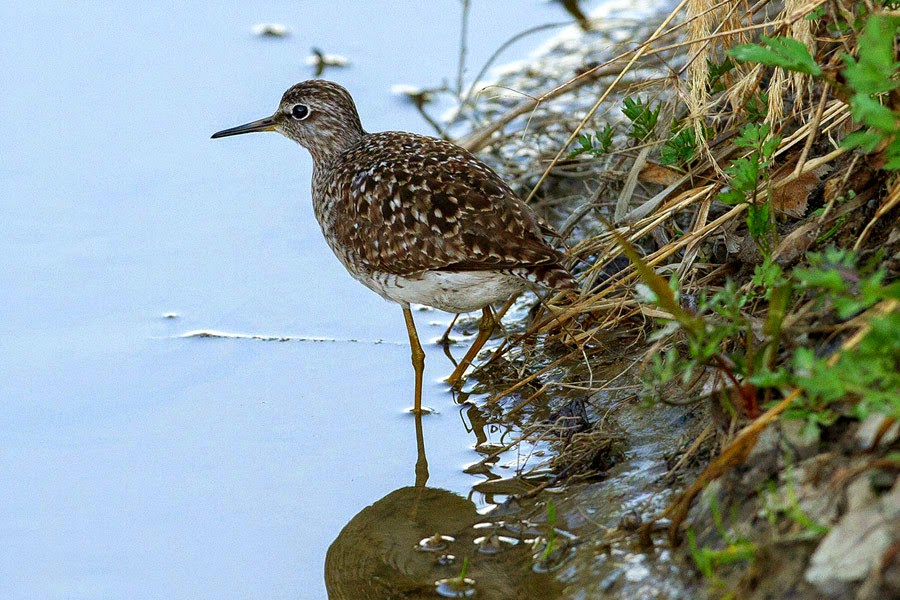The lagoon of Fuente de Piedra is located in the north of
the province of Malaga, Spain. It is 50km from the Mediterranean coast and 410m
above sea level. The lagoon is a seasonal salt lake with high salinity in
winter and a salt shell in summer. The lake has a maximum width of 2.5km and a
length of 6.5km, the maximum water surface area reaches up to 14km².
 |
| Fuente de Piedra - A view across the lagoon to the village |
Forming one of many wader hotspots in southern Spain, the
lagoon is perhaps best known for being the largest breeding site for Greater
Flamingo Pheonicopterus rubber in Spain;
in fact it has been since Roman times! The importance of this lake and the
surrounding marshlands was recognised and listed as RAMSAR site in 1982, the
listing triggered further steps to protect the area with the Andalucia
Parliament pronouncing it a ‘Integral Reserve’ in 1984, followed by planning as
a ‘Nature Reserve’ in 1989. In addition the EU selected it as a Special
Protection Area under the Bird Directive of the EEC during 1988. The nature reserve
occupies 1,554 hectares and its Peripheral Protection Zone covers an area of
6,689 hectares.
 |
| Temminck's Stint - recorded almost annually in the area |
For waders, and many other species of birds, the period from
March through to May is a time when there is more intense activity and a time
when both wintering and migratory birds show at the same time. Not surprising
as the water level and vegetation are most stable during the wet season.
Wintering and migratory waders are also joined by breeding birds during this
period. Most common breeding waders are Black-winged Stilt, Avocet,
Little Ringed and Kentish Plover, with Eurasian Thicknee (Stone Curlew) breeding in the
surrounding area. Depending on water levels, springtime migration can be
spectacular, particularly for waders in their summer plumage. Collared
Pratincole, Curlew Sandpiper, Black-tailed Godwit, Ruff, Ringed Plover, Little
Stint and Dunlin pass through in large numbers, whilst Temminck’s Stint is
recorded each year. Wood Sandpiper are another that can be common with it’s
close relative Green Sandpiper wintering as well as increasing during migration
in the spring period. Common Sandpiper is almost ever present, with Lapwing
also surprisingly common at times. Other species such as Grey Plover, Spotted
Redshank, Greenshank, Sanderling, Bar-tailed Godwit and Whimbrel are regular
but scarcer migrants.
 |
| Collared Pratincole - A favourite for birders visiting the lagoon |
Of course wintering birds, such as Golden Plover, Lapwing,
Snipe and odd Turnstone, overlap with migratory waders. Also the area can
attract the odd rarity or two with Pectoral Sandpiper, Marsh Sandpiper and
others being recorded.
 |
| Wood Sandpiper - Common migrant and elegant visitor |
So the area is hugely important on a broad basis for not
just migration staging, but also wintering and breeding waders. The dramatic
decline of many waterbird species throughout Europe can be attributed largely
to wetland loss and degradation, with the expansion and irrigation of olive
plantations one important reason for this in Andalucia and most likely Spain in
general.
 |
| Eurasian Thicknee (Stone Curlew) - Breeds in the area and winter visitor |
Note. A global biodiversity hotspot, the wetlands around the
Mediterranean are important for over 100 species of waterbirds represented in
the Paleartic, North Africa and Middle East regions. 150 species of migratory
birds are estimated to use these wetlands as seasonal or stopover locations,
this represents bird populations of 2 billion (IUCN, 2005)! As part of the most
threatened aquatic ecosystems, more than 50% of Mediterranean wetlands have
been destroyed by human activities. It needs urgent attention and study to see
what impact irrigated crops, and particularly olive plantations, are having on the
water level in wetlands.
 |
| Fuente de Piedra in Spring - Visitor Centre and walkways |
 |
| Greater Flamingo is the reason for many to visit the lagoon |
Why not join Peter on one his Day
Tours? See Links below.
Serranía de Ronda – My
Mountains – for further information read HERE
Osuna – Steppe Country – for
further information read HERE
Campillos - Mountains to
Lagoons - for further information read HERE
Strait of Gibraltar -
Migration, wetlands and so much more read HERE
 |
| CLICK HERE TO VIEW OUR MAIN WEBSITE |

3 comments:
Oh to see those glorious Flamingos in flight like that, must be amazing! The Collared Pratincole and the Stone Curlew are new to me and absolutely marvelous Peter~
It must be wonderful to ssee the flamingoes ingreat quanity and that is a beautiful flight shotof yours.
Thanks Mary and Margaret. The lagoon is an amazing place for Greater Flamingo, with up to 38,000 adults milling around. Certainly one of the best, if not the best breeding area in Europe.
Post a Comment